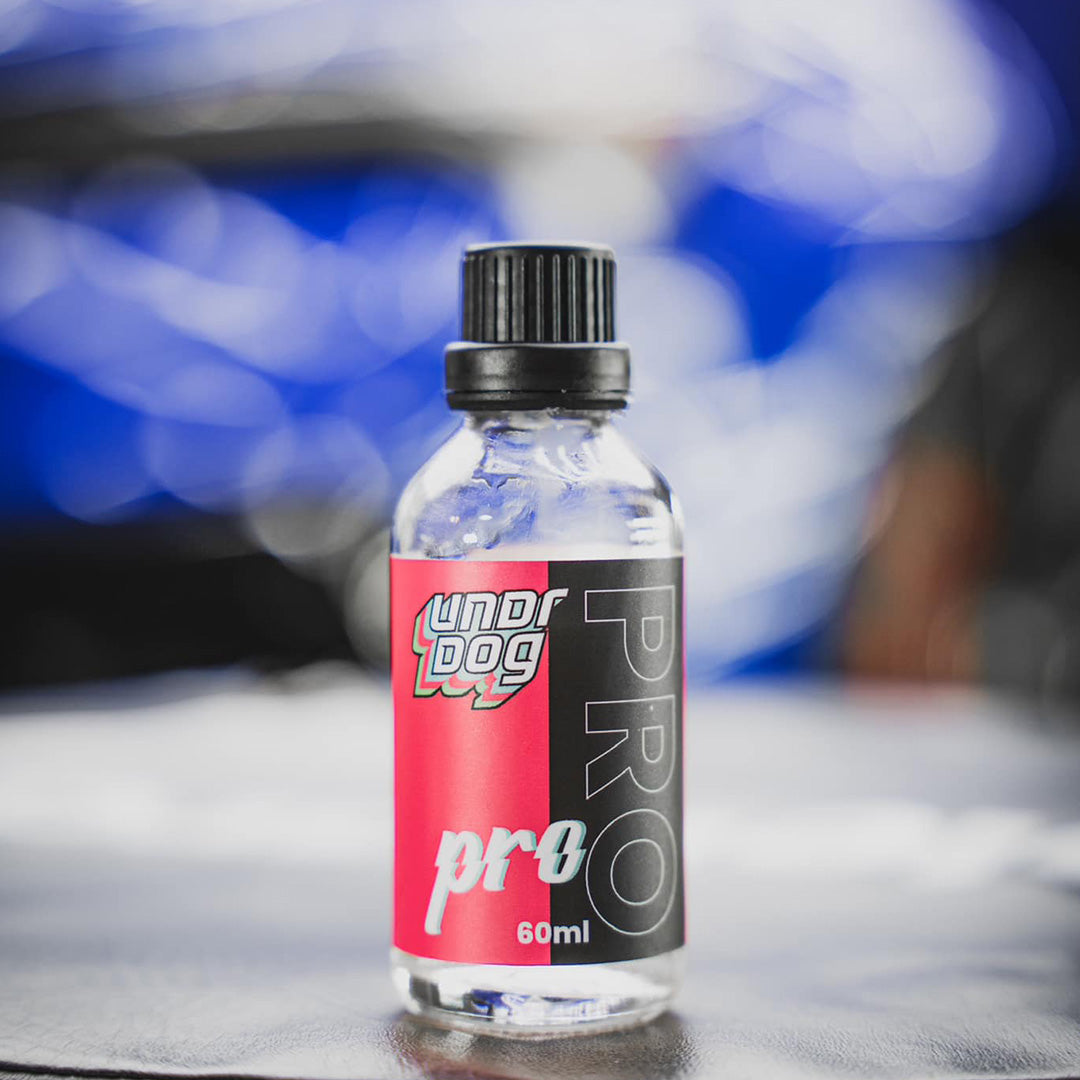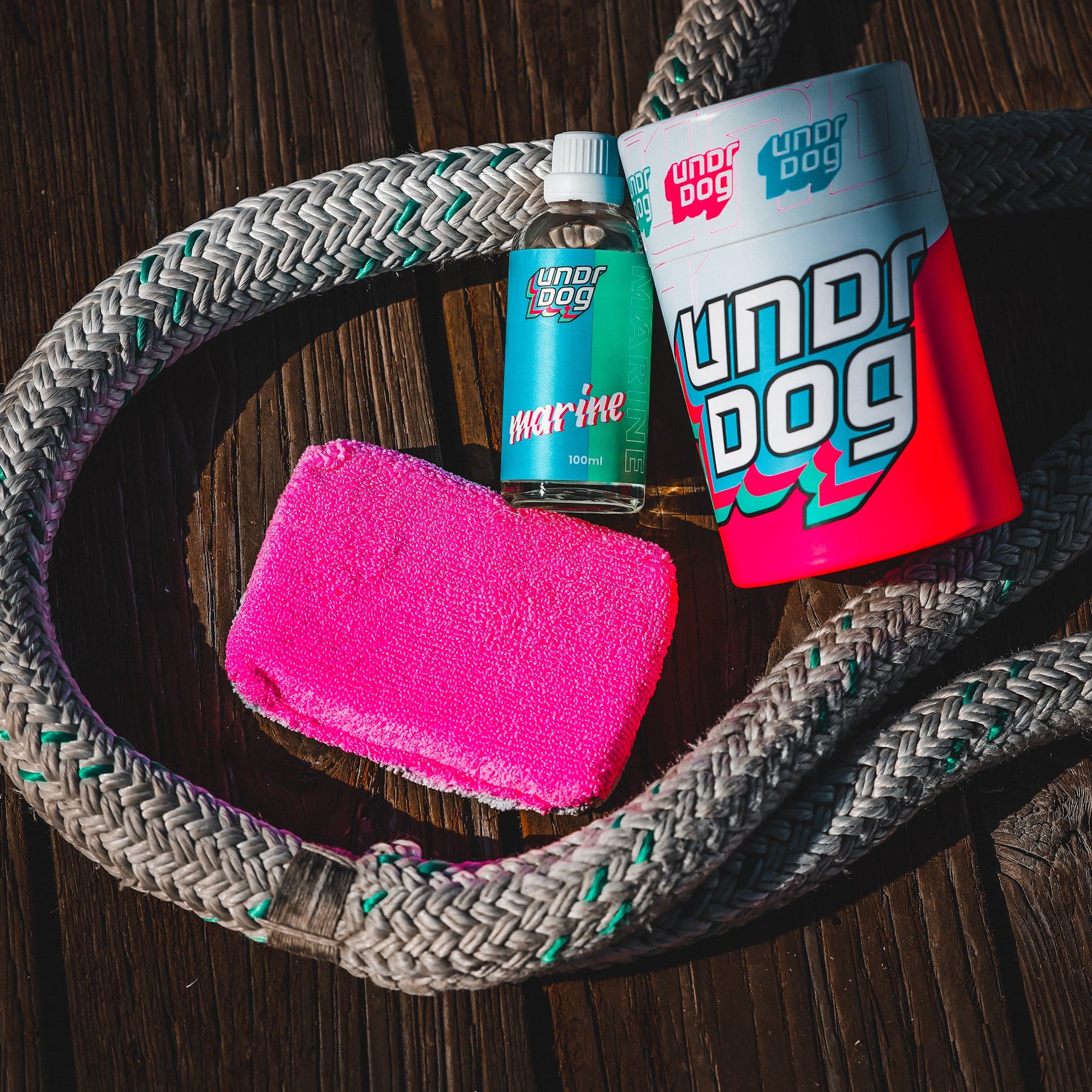Undrdog HCC — Application Manual
Applies to painted surfaces, glass, plastics, leather, and metals
The Easiest, most Efficient and most Effective way to Apply HCC. Please do not apply it another way, we believe thru testing this is the best way to apply.
Read First
- HCC can be applied inside or outside in most conditions above 32°F / 0°C.
- The same application process is used on all supported surfaces; see the Surface‑Specific Notes for tips.
- Always do a test spot in an inconspicuous area before full application.
Goal of the method: build a significantly thicker, more uniform coating by applying, letting it haze briefly, then re‑working the surface with the same applicator before a final microfiber leveling.
Safety & Handling
- Work in a well‑ventilated area.
- Wear nitrile gloves and eye protection; avoid skin and eye contact.
- Do not ingest. Keep away from children and pets.
- Keep away from ignition sources. Do not smoke during use.
- If product contacts skin: wash with soap and water. If it contacts eyes: rinse with water for several minutes and seek medical advice if irritation persists.
Tools & Supplies
- HCC bottle
- Applicator pad (foam or microfiber block)
- Microfiber towels (at least 3 clean, edgeless, short‑pile)
- Wax & Grease Remover (panel wipe)
- Lighting for inspection (handheld LED works well)
- Optional: painter’s tape (mask edges/emblems), small detailing brushes for textured plastics, glass‑specific towel for final glass buff
Environment & Conditions
- Minimum temperature: 32°F / 0°C (do not apply at or below freezing).
- Ideal range: 50–85°F (10–30°C) with low to moderate humidity.
- Work on cool, dry panels out of direct sun and strong wind when possible. If this is not possible HCC has been designed to be able to be applied in direct sunlight
Adjusting for climate:
- Hot/Dry/Sunny: work smaller sections, shorten haze time to 5–10 s.
- Cool/Humid: lengthen haze time to 20–30 s (up to 45 s if needed).
Surface Prep (All Surfaces)
- Wash the vehicle thoroughly and dry completely.
- Ensure the surface is free of contaminants (e.g., tar, fallout, polishing dust). Decontaminate if needed.
- Wipe the surface with a solvent based Wax & Grease Remover to remove any oils or residues and promote bonding.
- If you are not coating certain porous materials, mask them now.
The better the prep, the better the bond and the finish.
Application Method (All Surfaces)
This is the same process for paint, glass, plastics, leather, and metals.
- Shake the HCC bottle vigorously for 60–90 seconds to re‑suspend any settled solids.
- Prime the applicator pad: add product until it’s evenly damp (not dripping).
- Choose a section no larger than arm’s‑width.
- Apply in a cross‑hatch pattern (overlapping straight lines, north‑south then east‑west) to ensure even, consistent coverage.
- Allow the product to haze lightly for 10–30 seconds (adjust per climate).
- Using the same applicator pad, go back over the section with light pressure to re‑work the product.
- Repeat passes with the applicator until the visible residue is reduced to almost nothing.
- Use a clean microfiber towel to level/remove the remaining residue until the surface appears uniform and streak‑free (flip towel frequently).
- Overlap the next section slightly to avoid missed spots.
- Conduct a final inspection from multiple angles with bright light. If you spot a high spot or smear, place one small drop on the applicator, re‑work that area, and re‑level with microfiber.
This two‑stage “apply → short haze → re‑work → level” technique builds a thicker, more uniform coating and consistent appearance.
Surface‑Specific Notes & Tips
Painted Surfaces (Gloss, Satin, Matte)
- Gloss paint: Follow the standard method. Avoid heavy buildup on edges and around emblems.
- Satin/Matte paint: Apply sparingly and maintain even coverage to prevent dark patches. Shorten haze time if you see rapid flashing. Always test a small area first.
- Final wipe should not increase gloss on matte; keep pressure light and ensure uniformity.
Glass (Exterior & Interior)
- Clean glass thoroughly; a panel wipe after regular glass cleaner helps remove hidden oils.
- Apply thin and buff thoroughly to avoid smearing.
- For windshields: after leveling, do a final pass with a dedicated glass towel.
- Tinted film & defroster lines: safe on bare glass; avoid pooling along film edges and across defroster traces; always test first.
Plastics & Trim (Interior/Exterior)
- Smooth plastics (piano black, glossy trim): standard method.
- Textured/porous plastics: use light product, work it into the texture, then level promptly to prevent blotching; expect slight darkening—test first.
- Rubber seals: may darken; apply sparingly and immediately level.
Leather (Finished/Coated Automotive Leather Only)
- Not for: suede, alcantara, nubuck, or unfinished aniline leather.
- Clean with a gentle leather cleaner and dry fully.
- Apply sparingly to the applicator (not directly to leather), work small areas, then immediately level to a dry, natural finish.
- Remove any excess from stitching and perforations. If the surface feels too slick, wipe once more with a slightly damp microfiber to neutralize.
Metals (Chrome, Stainless, Aluminum, Polished/Brushed)
- Polish/de‑oxidize first if needed, then panel‑wipe.
- Apply thin, follow the grain on brushed finishes, and buff thoroughly to a clear, even appearance.
- On bare aluminum or soft alloys, test a small area to confirm the look before proceeding.
Curing & Aftercare
- Keep coated areas dry and untouched for at least 2 hours (longer in cool/humid conditions).
- Avoid washing or strong cleaners for 5–7 days to allow the coating to fully set.
- Routine care: pH‑neutral washes, soft mitts, and clean microfibers.
- Optional: If you use a topper/quick detailer, wait at least 1–2 Months before first application and test the look on a small area.
Troubleshooting
- Streaks / Smears: Usually too much product or long haze time. Re‑apply a tiny amount to the area, re‑work with the pad, and re‑level.
- Rainbow sheen / high spots: Re‑work with a drop on the applicator, then buff.
- Residue won’t reduce: Shorten haze time and/or work smaller sections; ensure the panel is cool and clean.
- Grabby towel: Switch to a fresh microfiber; contaminated towels can smear.
- Uneven darkening on textured plastics: Use less product, work it in with a soft brush if needed, and level immediately.
Storage & Shelf Life
- Store tightly sealed in a cool, dry place away from sunlight. Can last for years
- Do not allow to freeze.
- Shake before every use.
Quick‑Start (1‑Page Summary)
- Prep: Wash → Decontam → Panel wipe.
- Shake 60–90 s.
- Prime pad lightly.
- Work arm’s‑width area.
- Cross‑hatch apply for even coverage.
- Let haze 10–30 s (adjust for climate).
- Re‑work with same pad until residue is nearly gone.
- Microfiber level to a streak‑free finish.
- Overlap next section; inspect with bright light.
- Keep dry ≥2 h, avoid washing 5–7 days.
© Undrdog. All rights reserved.





